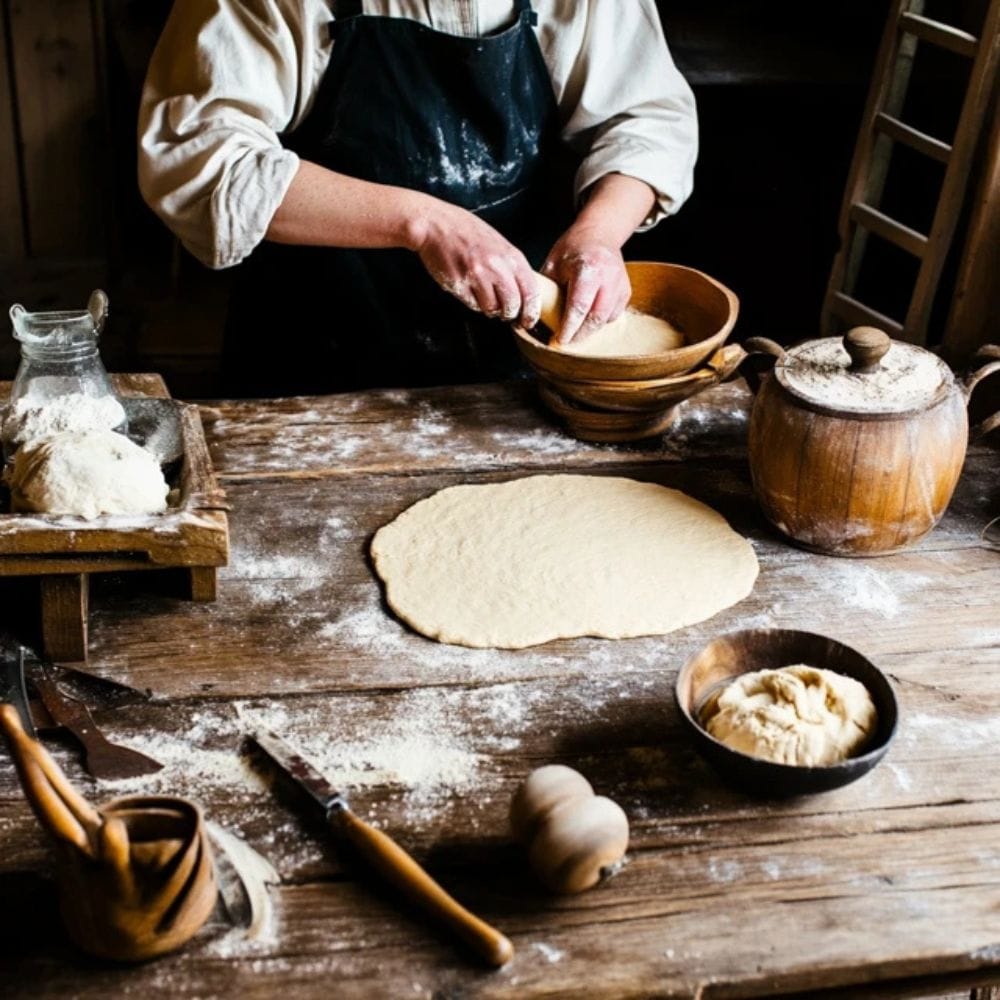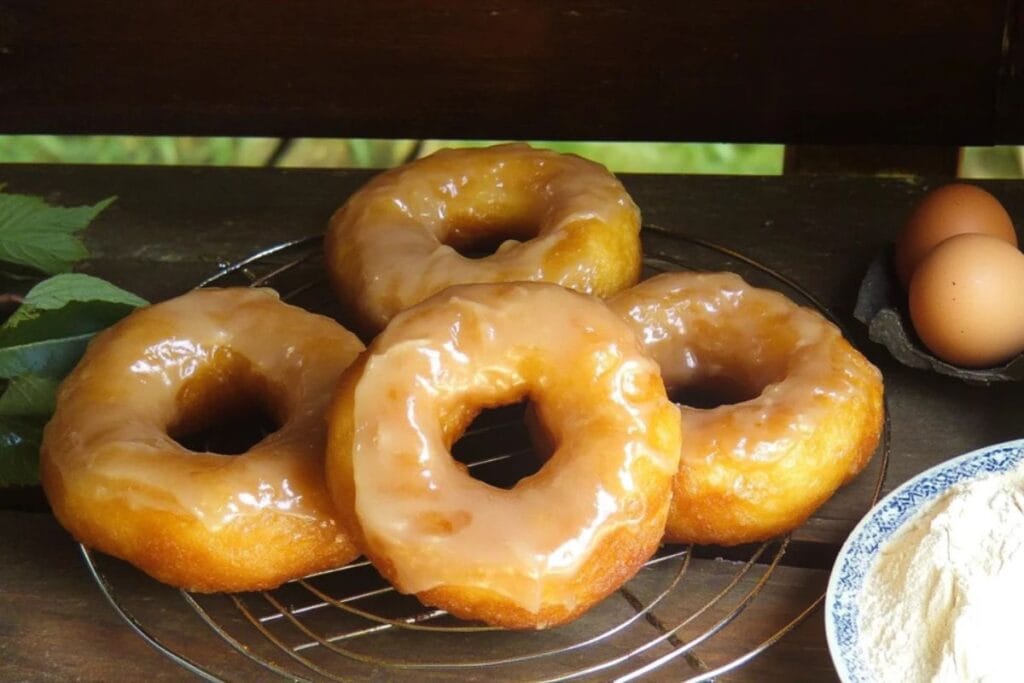These Amish doughnuts are something special. They have a tender crumb and a slightly crisp exterior. Folks often savor one and wonder why each bite is so satisfying. One reason is the way these doughnuts are made with simple steps and time-honored traditions. Another reason is the way they connect people to a slower style of life, where each recipe is kept close to the heart.
They taste buttery, sweet, and fresh. Even so, they feel lighter than many store-bought varieties. Certainly, that kind of flavor does not happen by accident. Patience, attention to detail, and honest ingredients come together to create these Amish doughnuts. Many bakers say their secret lies in the extra care and sense of purpose that go into every batch.
The Rich Tradition of Amish Baking

These communities have preserved old-fashioned baking customs for generations. They often rely on time-tested doughnut recipes that were scribbled into worn notebooks long ago. Bakers might learn from elders in a warm kitchen, listening to stories and forming deep bonds. Meanwhile, everyone shares a genuine desire to honor family legacies, so these traditions remain alive and well.
Amish families keep food preparation at the center of home life. There is a daily rhythm to it all, with many chores done by hand. Although modern conveniences pop up elsewhere, the essence of slow baking still stands strong. People cherish the calm, satisfying act of mixing and shaping dough. Consequently, traditions are passed from one generation to the next.
Historical Roots of Doughnut Making
Early Amish bakers adapted doughnut recipes from European pastries, blending local resources with classic sweet dough methods. They shaped dough by hand and allowed it to rise in a cozy spot. This practice developed consistent textures that folks grew to crave. Over time, families traded ideas, ensuring each home put its own spin on the same comforting treat.
Many older recipes relied on fresh lard as the frying medium. Even so, each batch carried a consistent theme of quality. Amish women often prepared large doughnut spreads for barn raisings or church gatherings. People soon associated these baked goods with warmth and celebration. They also noticed the unique taste, which stood out from typical store-bought pastries.
Cultural Significance in Everyday Life
Baking means more than just supplying food. It symbolizes hospitality, diligence, and pride in one’s skills. Families often gather in the kitchen, each person taking a task like shaping rings or coating the finished doughnuts with sugar. This tradition fosters unity, which resonates in the finished product. Neighbors may drop by, knowing fresh pastries are usually waiting.
Holidays and church events frequently feature sweet desserts. People see them as a highlight of social gatherings. Doughnuts, pies, and breads have symbolic roles in Amish culture, representing shared blessings and communal support. At harvest time, there’s an even greater emphasis on homemade goods. That sense of rhythm and seasonality enriches each batch of doughnuts.
Quality Ingredients: The Foundation of Flavor
Freshness drives flavor, and that principle remains at the heart of Amish doughnuts. The use of locally sourced, high-quality ingredients ensures that every batch carries an unmatched depth of taste and texture. Unlike mass-produced alternatives, Amish kitchens depend on farm-fresh supplies, avoiding preservatives and artificial additives. This dedication to natural ingredients gives Amish doughnuts their distinct homemade appeal.
The Role of Fresh, Local Ingredients in Amish Doughnuts
The secret behind the incredible taste of Amish doughnuts lies in the freshness of each ingredient. Every component plays a crucial role in shaping the dough’s texture and flavor:
- Unbleached Flour – Provides a hearty, natural base that enhances the dough’s consistency.
- Farm-Fresh Eggs – Adds richness and elasticity, giving Amish doughnuts their signature softness.
- Local Honey or Granulated Sugar – Sweetens the dough without overpowering other flavors, allowing for a balanced, smooth taste.
- A Dash of Salt – Enhances flavor and prevents the dough from tasting overly sweet.
- Well Water – Many Amish bakers claim that using fresh well water improves the dough’s texture and taste, creating better Amish doughnuts than those made with treated water.
Since most ingredients are locally sourced, the quality of Amish doughnuts remains consistent, though regional variations in wheat and dairy can bring slight yet delightful differences in flavor.
Importance of Traditional Fats in Amish Doughnuts
The fat used in Amish doughnuts significantly impacts their texture and overall taste. Unlike modern bakeries that rely on processed oils, Amish kitchens still prefer time-honored fats, which yield rich and flavorful results:
- Lard – Creates a crispy, golden exterior while adding a subtle savory depth.
- Real Butter – Brings a gentle sweetness and creamy richness to the dough.
- Combination of Both – Some bakers mix lard and butter for the perfect balance of crispness and tenderness.
Though some may opt for vegetable shortening for cost-saving reasons, the most authentic Amish doughnuts are crafted using old-fashioned fats, ensuring a superior taste and texture.
Balancing Sweeteners for the Perfect Amish Doughnuts
Beyond the essential ingredients, the choice of sweeteners plays a vital role in defining the final taste of Amish doughnuts. Bakers carefully select and blend sweeteners to achieve a harmonious flavor:
- Granulated Sugar – Provides a classic, straightforward sweetness that caramelizes slightly during frying.
- Honey – Introduces a mild floral note and natural depth, enhancing the dough’s overall richness.
- Molasses – Occasionally used for a richer, more robust sweetness, often in darker doughnut varieties.
A well-balanced approach ensures that Amish doughnuts maintain their signature soft texture and delicious flavor without being overly sweet.
The dedication to fresh, high-quality ingredients remains the secret behind the timeless appeal of Amish doughnuts. By following traditional methods, these doughnuts continue to deliver the perfect blend of taste, texture, and nostalgia, making them an unforgettable treat.
Traditional Amish Baking Techniques
Many Amish bakers rely on muscle power to prepare dough, kneading it by hand until it develops the right consistency. Well-worn mixing bowls, passed down through generations, hold the history of countless batches of Amish doughnuts. Dough is left to rest in a draft-free area, where time works its magic, enhancing flavor and texture. This patient method results in a fine crumb and a soft, airy bite.
However, technique alone doesn’t guarantee success. The entire baking process—from proofing yeast to monitoring oil temperature—is carefully managed. Experienced bakers:
- Adjust resting times based on the kitchen’s warmth.
- Use the poke test to check if the dough springs back, signaling readiness.
- Ensure proper gluten development by kneading just enough to create structure without making the dough tough.
These small, meticulous steps contribute to the exceptional texture and taste of Amish doughnuts.
Handcrafted Amish Doughnut Dough Preparation
Making Amish doughnut dough follows a precise method, requiring careful handling and the right balance of ingredients.
- Activating the Yeast: A warm mixture of yeast, sugar, and water is combined and left to bubble.
- Mixing the Dough: Eggs, flour, and melted butter or lard are incorporated. A sturdy spoon or the baker’s hands bring everything together.
- First Rise: The dough is gently kneaded and then left to rest and develop structure.
- Second Rise: The dough is placed back in a bowl, covered, and kept in a warm corner. This extra rise makes the dough plush yet sturdy.
- Shaping the Doughnuts: Once fully risen, the dough is patted out, cut into rounds, and given time to puff up before frying.
Some bakers prefer a bit of extra kneading to develop more gluten, while others believe a gentler touch results in softer Amish doughnuts. Both techniques can yield excellent results, depending on the desired texture.
Frying Methods for Amish Doughnuts
Frying is a crucial step in creating the golden, airy texture of Amish doughnuts. A well-seasoned cast-iron pot is a staple in many Amish kitchens, as it retains and distributes heat evenly.
- Maintaining Proper Temperature:
- If the oil is too cool, the doughnuts absorb excess oil, making them greasy.
- If it’s too hot, they burn on the outside while remaining raw inside.
- Many bakers use a candy thermometer to keep the temperature consistent.
- The Frying Process:
- Dough rounds are gently lowered into the hot fat, where they quickly puff up and turn golden.
- Bakers carefully flip each doughnut to ensure an evenly crisp, light texture.
Mastering these frying techniques ensures Amish doughnuts achieve the perfect balance of crunch and tenderness, making them a treasured treat among those who appreciate traditional baking.puffed.
Meanwhile, some folks refer to more detailed steps handed down through families. They might mention timing or color cues, as well as ways to flip the doughnuts gently. Once each round is done, it’s placed on racks or paper to drain. To learn more about traditional Amish doughnut-making methods, see traditional Amish doughnut-making methods.
| Frying Tips | Observations |
|---|---|
| Oil Temperature | Aim for roughly 365°F for balanced browning. |
| Frying Utensil | Use a slotted spoon or spider for easy retrieval. |
| Drain Properly | Place on paper or racks to remove excess oil. |
The Community Aspect of Amish Baking
Group baking days create lively gatherings. Relatives and friends handle tasks at long tables, shaping dough, stirring fillings, and sharing stories. The vibe is warm, and laughter rings out as people produce large quantities. They pass on advice through conversation, not formal classes. These moments strengthen friendships, reinforcing the sense of unity that defines many Amish gatherings.
Some families send younger helpers on errands to fetch extra flour or sugar from the pantry. Others invite neighbors to sample the goods. The entire experience goes beyond doughnuts: it creates a bond. Often, children learn vital life skills, from measuring ingredients to appreciating steady effort. In many Amish communities, doughnut-making days are a highlight.
Baking as a Social Activity
Neighbors might arrive early with baskets of supplies. They chat while measuring ingredients, recalling old stories about past frosty mornings or local fairs. Then, they work in unison, forming dozens or even hundreds of doughnuts. This social angle keeps old recipes alive. It also ensures no one person shoulders the burden alone.
When the doughnuts are done, folks rest and sip hot beverages. They share fresh pastries, marveling at the uniform rings and fragrant steam. Indeed, that sense of togetherness contributes to the final taste. Because these sessions are about connection, the process feels joyful rather than tedious. Doughnut-making becomes a memory in the making.
Economic Role of Local Treats
Amish farmers sometimes sell doughnuts at roadside stands. Visitors love the sweet aroma and often line up early. Sales can help fund household expenses or community projects. This direct-to-consumer approach is part of an honest exchange, where fresh goods meet eager customers. Shoppers sense the authenticity and return repeatedly to get more.
Local farmers’ markets also provide a channel for revenue. People often gather on weekends, hoping to find Amish pastries that remind them of simpler times. The combination of quality and tradition makes these goods popular. Even after the last doughnut is sold, folks keep talking about that wonderful taste. That reputation boosts future sales.
Some Amish families rely on baked goods as a key income source, reinforcing the value of each carefully made doughnut.
The Sensory Experience of Amish Doughnuts
Biting into an Amish doughnut is an experience unlike any other. The contrast between a delicate, crispy exterior and a soft, pillowy interior excites the palate, offering a texture that is both light yet satisfying. These doughnuts carry a gentle sweetness that never feels overpowering, making it easy to reach for another bite.
Freshly fried Amish doughnuts fill the kitchen with a warm, comforting aroma, instantly making them irresistible. That scent alone evokes nostalgia and homeliness, especially when the doughnuts are enjoyed warm from the fryer. Unlike heavier pastries, they remain light and airy, ensuring that one can indulge without feeling weighed down.
Texture: Fluffy Interiors of Amish Pastries
One of the hallmarks of Amish doughnuts is their feather-light crumb. This cloud-like texture is achieved through yeast-based dough, proper kneading, and careful rising times. Bakers follow time-honored techniques to create the perfect balance of fluffiness and structure.
- Proper Kneading – Develops air pockets and elasticity, ensuring the doughnut remains light yet structured.
- Ideal Rising Time – Allows the dough to expand fully, creating an airy and tender bite.
- Consistent Oil Heat – Prevents uneven cooking and soggy interiors, leading to a perfectly crisp yet delicate finish.
Each step, from the initial dough rest to the final proofing, contributes to the doughnut’s iconic texture. Amish bakers often use the finger-press test, gently poking the dough to see if it springs back slowly—a sign that it’s ready for frying. This careful approach ensures every batch maintains the soft, airy quality that sets Amish doughnuts apart from mass-produced versions.
Flavor Profile: Balancing Sweetness
The flavor of Amish doughnuts is delicate and well-balanced, allowing the natural richness of butter, eggs, and fresh flour to take center stage. Unlike overly sugary confections, these doughnuts offer a mild sweetness that complements their tender bite.
- Hints of Spice – Some bakers incorporate nutmeg or cinnamon to add a subtle warmth.
- Classic Vanilla Notes – A touch of vanilla extract highlights the natural flavors of the dough.
- Rich Fats Enhance the Taste – The use of butter or lard lends depth and a comforting richness.
Many believe that wholesome, farm-fresh ingredients are the secret to the unparalleled taste of Amish doughnuts. The dough itself isn’t designed to be overly sweet, ensuring that even with glazes or sugar dustings, the pastry remains light, comforting, and timeless.
Taste-testers often describe Amish doughnuts as perfectly sweet with a richness that never feels heavy. This balance of flavors and textures is what makes them a cherished classic, beloved by those who appreciate traditional, handcrafted baked goods.
Variations of Amish Doughnuts
Bakers create a wide range of Amish doughnuts, offering different textures, flavors, and toppings. Some families prefer a classic, plain ring dusted with powdered sugar, while others coat them in a smooth, glossy glaze for extra sweetness. More adventurous bakers drizzle homemade icing flavored with maple or chocolate, adding a personalized touch.
While the base dough remains consistent, each variation introduces a new flavor experience. Whether topped, filled, or spiced, Amish doughnuts always maintain their signature soft and airy texture.
Glazed vs. Sugared Toppings for Amish Doughnuts
The choice between glazed or sugared doughnuts impacts both taste and texture:
- Glazed Doughnuts – Made with a simple mix of milk, powdered sugar, and vanilla, the glaze forms a thin, crisp shell that cracks upon the first bite, revealing the tender interior.
- Sugared Doughnuts – A coating of granulated or powdered sugar adds a light crunch that contrasts beautifully with the soft, warm dough.
Some bakers even combine the two for a unique twist:
- Glaze + Cinnamon Sugar – A light coating of glaze followed by a dusting of cinnamon sugar for extra warmth.
- Chocolate Glaze – Cocoa powder mixed into the glaze gives a richer, dessert-like taste.
No matter the topping, the core appeal of Amish doughnuts remains their freshness and delicate crumb, with each variation simply enhancing their already delicious flavor.
Fillings and Flavor Additions in Amish Pastries
Beyond toppings, many bakers fill Amish doughnuts with classic, homemade fillings, adding another layer of indulgence. These filled versions are often round rather than ring-shaped, sealing the sweet surprise inside.
Popular Fillings Include:
- Fruit Jellies – Made from local berries, including strawberry, blueberry, and raspberry, these fillings add a vibrant, tart contrast to the rich dough.
- Custard or Pastry Cream – A smooth, creamy center that blends perfectly with the airy texture of the doughnut.
- Chocolate or Caramel – A decadent option for those who love deep, rich flavors.
Some bakers even enhance the dough itself with spices and extracts:
- Cinnamon or Nutmeg – A subtle, warming spice that brings out the natural flavors of the flour and yeast.
- Vanilla Extract – Enhances the sweet, buttery notes of the dough.
- Pumpkin Spice or Caramel Drizzle – A seasonal twist perfect for fall gatherings.
Despite these flavorful additions, the true charm of Amish doughnuts lies in their traditional preparation and fresh ingredients. While new flavors bring variety, the timeless techniques behind these treats remain unchanged, ensuring that every bite delivers a taste of homemade perfection.
Nutritional Insights
Amish doughnuts are undeniably delicious, but they remain an indulgence. Their rich flavor comes from high-quality fats, sweeteners, and fresh ingredients, which also contribute to their calorie content. Those who enjoy them regularly often note their buttery richness and satisfying texture. However, many families adopt a balanced approach, savoring them in moderate serving sizes rather than overindulging.
Rather than being everyday treats, Amish doughnuts are typically reserved for special occasions, such as family gatherings, festive celebrations, or weekend breakfasts. This tradition helps keep them special and appreciated, rather than an everyday habit. Many Amish households prioritize wholesome, home-cooked meals, balancing their diet with vegetables, lean proteins, and whole grains while enjoying sweets in reasonable portions.
Caloric Content and Serving Sizes
The caloric value of Amish doughnuts varies based on ingredients and toppings:
- A plain doughnut typically contains 250–300 calories.
- A glazed or sugared doughnut may rise to 350 calories or more due to added sweeteners.
- Doughnuts made with real butter or lard tend to have higher fat content, which increases calories.
Portion awareness helps maintain balance:
- Half a doughnut paired with fresh fruit or yogurt offers a lighter option while still satisfying a craving.
- Enjoying them alongside a well-rounded meal prevents overeating and promotes satisfaction without excess.
- Many Amish families bake large batches to share, reinforcing community and mindful indulgence.
Doughnuts are rarely eaten on their own—they are often part of a larger meal that includes fresh, homemade foods, ensuring variety and overall dietary balance.
Balancing Indulgence with Moderation
The key to enjoying Amish doughnuts without overdoing it is mindful consumption. People who pace themselves and appreciate each bite tend to find greater satisfaction in their treats.
- Pairing with coffee or tea – A warm beverage helps slow down consumption, making each doughnut more enjoyable.
- Reserving them for special occasions – Limiting consumption to weekends, holidays, or gatherings makes them feel extra special.
- Focusing on quality over quantity – Savoring one well-made doughnut is often more satisfying than eating several quickly.
- Sharing with family and friends – This practice reduces portion sizes naturally and aligns with the Amish sense of community and togetherness.
Rather than viewing Amish doughnuts as an everyday food, those who embrace moderation and balance find they can fully enjoy these treats without guilt or excess. By focusing on homemade quality and shared experiences, doughnuts remain a joyful, occasional indulgence rather than a dietary burden.
Tips for Making Amish Doughnuts at Home
Recreating Amish doughnuts in your own kitchen can be an enjoyable and rewarding experience. A great batch begins with a solid recipe, high-quality ingredients, and proper frying techniques. Home bakers should opt for unbleached flour, which ensures the dough stays firm yet tender. Yeast activation is key, and letting it proof until slightly sweet-smelling helps create a light and airy texture. Once the dough is prepared, careful shaping and resting ensure consistent, fluffy results.
One of the biggest challenges is maintaining proper oil temperature. A kitchen thermometer is essential to prevent greasy or undercooked doughnuts. Patience is equally important—rushing the dough’s rise can compromise fluffiness, while letting it rest too long may create an off flavor. By balancing time, temperature, and technique, home bakers can master the art of making perfect Amish doughnuts.
Selecting Ingredients for Homemade Amish Doughnuts
The best homemade Amish doughnuts come from high-quality, fresh ingredients. Even if local farm ingredients aren’t available, choosing premium, additive-free options will make a noticeable difference.
- Flour: Opt for unbleached, high-protein flour to maintain the dough’s strength without sacrificing tenderness.
- Eggs: Farm-fresh eggs add richness and color to the dough.
- Sweeteners: Use granulated sugar or mild honey to balance sweetness without overpowering flavors.
- Fats: Butter or lard gives the doughnuts their signature richness and crispness.
- Salt: A small amount enhances all the flavors, preventing the dough from tasting flat.
- Yeast: Fresh yeast is crucial—if it doesn’t foam when proofed in warm water, replace it with a new batch.
For those looking to experiment, a touch of vanilla or nutmeg can add subtle depth. However, it’s best to start with a simple, classic version before venturing into variations.
Mastering the Technique
Achieving perfect Amish doughnuts depends on mastering the dough’s consistency and frying method.
- Proof the Yeast – Combine warm water, sugar, and yeast, allowing it to foam before adding other ingredients.
- Mix the Dough – Blend eggs, melted butter, and flour, kneading until the dough is soft but not sticky.
- First Rise – Let the dough rest for about an hour in a warm, draft-free area.
- Shape the Doughnuts – Punch down the dough, roll it out, and cut into rounds.
- Second Rise – Allow shaped doughnuts to puff up before frying, ensuring the final texture remains light and airy.
- Frying at the Right Temperature – Maintain the oil at 365°F (185°C) and fry in small batches.
- Finishing Touches – Drain doughnuts well, then coat them in glaze, cinnamon sugar, or powdered sugar.
Technique Tips:
✔ Keep flour on hand for dusting to prevent sticking.
✔ Turn the dough only once in the fryer for even cooking.
✔ Drain thoroughly on paper towels to prevent sogginess.
Common Mistakes to Avoid
Even experienced bakers can struggle with doughnut-making mistakes. Learning from these pitfalls helps ensure consistent success.
Overproofing or Underproofing
Getting the rise just right is crucial for light, fluffy Amish doughnuts.
- Overproofing – Letting the dough rise too long can cause it to collapse or develop a sour flavor.
- Underproofing – Cutting the resting time short results in a dense, tight crumb.
Tip: Gently press the dough with a fingertip—if it springs back slowly, it’s ready to fry. Room temperature plays a role, too. Warmer kitchens speed up proofing, while cold environments slow it down. Monitoring the dough carefully ensures optimal texture.
Incorrect Oil Temperature
Frying at the wrong temperature leads to poor texture and flavor.
- Too cool (below 350°F/175°C): Doughnuts absorb excess oil, turning greasy and heavy.
- Too hot (above 375°F/190°C): The outside burns too quickly, leaving the inside undercooked.
Tip: Use a candy or deep-fry thermometer to maintain an even 365°F throughout frying. Adding too many doughnuts at once lowers the temperature, so give the oil time to recover between batches. Gently stirring helps distribute heat evenly.
Once doughnuts turn golden brown, they’re ready to drain and enjoy. Mastering these details guarantees that homemade Amish doughnuts will rival the best from traditional bakeries.s consistent results.
FAQs: Common Questions
What makes Amish doughnuts different from regular doughnuts?Can I use alternative flours for Amish doughnuts?How should I store leftover Amish doughnuts?Are there vegan versions of Amish doughnuts?What occasions are these doughnuts traditionally made for?
Final Thoughts
Amish doughnuts capture both nostalgia and flavor in a single bite. That comfort stems from a time-honored process: fresh ingredients, thoughtful technique, and a strong sense of community. While they’re popular at local markets, their real charm shines brightest when made at home and shared with loved ones. Taste one, and you’ll know why people keep returning to these sweet treats.
Although modern conveniences abound, many bakers still embrace those older ways. They shape the dough by hand and let it rise until it reaches perfect softness. They watch the oil with care and finish each doughnut with a modest dusting or glaze. In the end, the simple charm and wonderful taste remind everyone that quality baking is about more than just a recipe.






